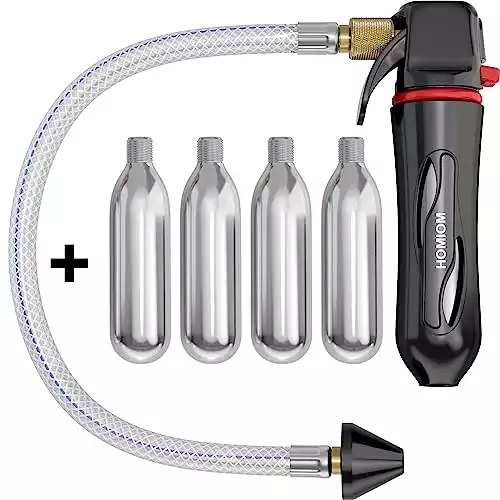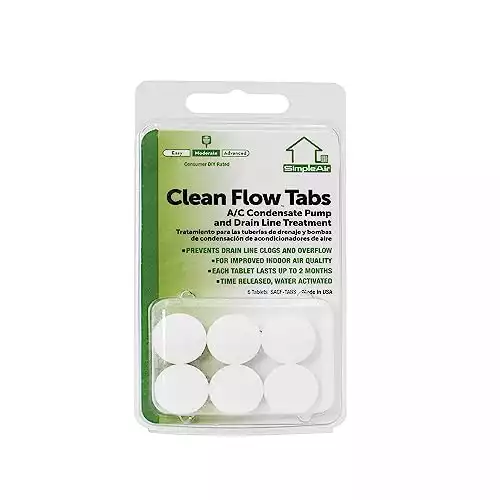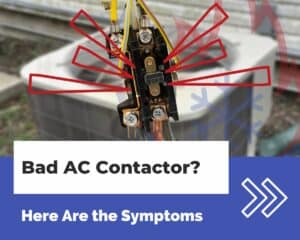HVAC Training Shop is reader-supported. As an Amazon Associate, I earn from qualifying purchases.
Did your AC suddenly stop cooling your home? Or maybe it shut down completely?
In either case, a clogged condensate drain line may be the cause.
In this article, I’ll go over the causes and symptoms of a clogged air conditioner condensate drain line. I’ll also let you know what you need to do if your AC’s condensate drain line is blocked.
AC condensate drain line clogged symptoms
If your air conditioner is exhibiting any of these symptoms, then it may be clogged:
- Standing water on the floor or walls near the AC unit
- Water leaking out of the AC unit
- AC completely shuts down and won’t run
- AC drain pan is full or overflowing with water
- Musty smell coming from your AC vents
- AC is not cooling your home
What causes a clogged AC drain line?
When an AC cools your home, it produces water as a byproduct of cooling the air. The water is removed from the AC by a drain line. The drain line goes from the air handler inside of your home to the drain line discharge outside of your home.
A clogged AC drain line is caused by a blockage inside of the drain line. Blockage can come from a variety of sources, including:
- Slime growth
- Dirt/dust/debris from inside of the air handler
- Dirt/dust/debris from outside of the home, blocking the discharge
- Insects/creatures climbing into the drain pipe and getting stuck
If you don’t remove the blockage from your drain line, water will build up in your AC’s drip pan. The water build-up can eventually get out of control and leak out of your AC unit—causing damage to your home.
How to unclog your AC condensate drain line
Unclogging an AC drain line is a fairly simple task that most homeowners will have to do at some point.
To unclog your AC condensate drain line, follow these steps:
1. Check to see how bad the clog is
Take a look outside where the drain line goes and see if there is any minor blockage. Sometimes, removing the clog is an easy fix that can be removed outside. Also, take a look inside the drain pan to see if the clog is in the line that connects to the drain pan.
2. Remove the clog by hand
If there is a minor clog, then you may be able to remove it by hand.
Find the drain line discharge. The discharge is usually located outside of your home, on the side of your house.
Poke a finger up the drain line on each end to see if you can remove the clog that way.
Sometimes, the clog is minor enough that you can easily remove it by hand and get your AC running quickly.
Other times, it takes a bit more effort to remove the clog from the condensate line. You’ll need to find your AC unit in your house and unclog it.
If your condensate drain line is still clogged, read further.

3. Turn off power to your AC unit
You’re going to be taking apart the drain line, so you need to turn off the power first. Find the disconnect switch for your AC unit and turn it off. Your AC needs to be off while you’re working on the condensate drain line.
4. Locate the condensate drain line
The next step is to find the condensate drain line’s point of entry into your AC unit. The condensate drain line will be connected to the air handling unit, usually in your garage or attic.
5. Clean and unclog the vent tee
The vent tee is located near the air handler. It usually has the top of the tee capped off with a plastic piece.
The vent tee serves as an access point to clean the condensate line. Remove the plastic cap and take a look inside the tee. You might find some slime build-up inside there! If so, you’ve found the source of your clog.
To clean out the vent tee, use a wet/dry vacuum to blow air through the tee. You may need to wrap a rag around the vent tee to form a seal with the vacuum hose.
If your vacuum is not strong enough to remove the clog from the condensate line, then you can use a drain gun instead. A drain gun will inject high-pressure gas into the drain line. The high pressure will remove almost any clog.
This drain gun uses high-pressure gas to clear condensate drains instantly. It has a flexible hose for easy use and comes with 4 CO2 cartridges.
6. Sanitize the drain line
After you blow the build-up out of the tee, use water to flush out the condensate line. Take a look at the discharge end of the line on the side of your house. You might be surprised at all of the debris that you blew out of your line.
You should also flush your drain line with vinegar to help break down and remove build-up. Pour a few cups of vinegar down the drain line and let it sit for 20-30 minutes to help break down sludge.
Some folks will tell you that you should pour bleach down your condensate drain. I’d advise against that—it’s usually unnecessary. Bleach also may kill your plants and damage the siding on your home.
Instead, use drain pan tablets to prevent growth in the first place. Drain pan tablets sit inside of your air handler’s drain pan and will neutralize organic growth before it starts.
Pop one of these Clean Flow tablets into your drain pan every month to keep slime growth away. Comes with 6 tablets so you'll be good for 6 months.
7. Test the drain line to make sure it’s clean and clear
After removing all the clogs, flush your drain line out with water to ensure that it is working properly. You should have clean, clear water flowing out of the drain line’s discharge.
Turn your AC unit back on and let the cool air flow!
What to do when your AC’s drain pan is full
If your AC’s drain pan is full, then you need to unclog its condensate drain line. The condensate drain line is the part of the AC that’s responsible for removing water from the AC’s air handling unit.
If the condensate drain line is clogged, your AC’s drain pan will fill up with water and shut down.
Why does your AC shut down when its drain pan is full?
The main reason is to prevent water from spilling out and causing damage to your home.
Another reason is to prevent damage to the AC unit. An AC unit that’s full of water will eventually break down.
How does your AC know when its drain pan is full?
The mechanism that is used to detect when a drain pan is full of water is a float switch. The float switch consists of a small float that moves up and down.
When the float is down, a switch is enabled to tell the AC’s control board that the drain pan is okay.
When the float moves up, the switch opens up and tells the control board that the drain pan is full. When this happens, the control board signals the rest of the AC to shut down so it doesn’t overflow with water.
So if your AC shuts down and won’t start back up, it could be due to the float switch. If the float switch moves up, your AC will shut down regardless of how much water is in the drain pan.
For more information about float switches, check out my article below:






Good morning.
My brother and I inherited my parents home and ran into the clogged drain pipe issue. Slime covered the whole inside of the condenser unit and the copper piping was severely clogged. We tried these methods and, most likely due to the age of the home, the copper pipe burst a few small holes after using the air gun. Any recommendations on what can be used in lieu of the copper piping and how to go about replacing it?
Thanks for all your great insight and tips. Very much appreciated.
Hi Michael,
Copper or PVC can be used to replace the condensate piping. You’ll find most systems using PVC nowadays since its cheaper and easier to work with.
It’s hard for me to say the best way to replace your piping without seeing it. You may be able to just replace the corroded section of copper with new copper piping. Or replace the whole thing with PVC.
Best of luck,
-Trey
Greetings Trey.
Glad to read you here. I am looking for an air compressor strong enough to clear condensation pipes. What psi(?) would you recommend. I am looking at the Dwalt pancake air compressor for example. Your knowledge could help an entire household. Thank you !
– ZK
Hi ZK,
A pancake air compressor should be fine. It usually doesn’t take much pressure to clear a clogged condensate drain pipe. It’s worth starting at the other end though – the outlet side. Use a wet/dry vac to try and suck the clog out before you try and blow it out with compressed air.
-Trey